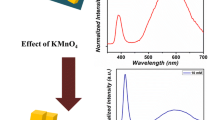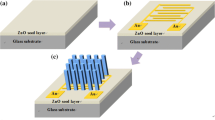Abstract
Ga doped ZnO nanostructures were synthesized by VLS mechanism in which Ga was simultaneously used as a catalyst as well as dopant with varied Ga layer thickness (1 nm, 3 nm, 5 nm and 10 nm). The synthesized ZnO NWs were studied for optical and UV light sensing characteristics. The morphology of grown nanostructures studied by SEM showed that the diameter of nanowires increased with the thickness of the Ga film increase. XRD patterns revealed that ZnO was present in Wurtzite (hexagonal) phase. In addition to ZnO an impurity phase of Ga2O3 was also observed in all synthesized ZnO NWs. The amount of Ga doping affected the position and intensity of ZnO (002) reflection peak in the XRD patterns. This was ascribed to two factors, one is substitution of Ga atoms at the Zn site in the ZnO crystal structure and secondly tendency of Ga to become interstitial. Room temperature and temperature dependent photoluminescence spectroscopy was performed to study the band edge and defected assisted luminescence. In the low temperature PL spectra, DAP transition at (3.30–3.32 eV) and neutral Ga donor bound exciton DoX lines were observed, which disappeared when the temperature was raised above 100 K, which confirmed the successful Ga doping in ZnO crystal structure. The PL intensity showed anomalous behavior as a consequence of tail edge states, which showed strong dependence on Ga content. It was observed that the activation energy for radiative transitions decreased rapidly while the activation energy for non-radiative did not decrease appreciably with the Ga content. This led to enhanced UV sensing characteristics of ZnO NWs with slow recovery time. It is demonstrated that the recovery time depended on the Ga content as it became slow for large Ga content.







Similar content being viewed by others
References
V. Galstyann, E. Comini, C. Baratto, G. Faglia, G. Sberveglieri, Nanostructured ZnO chemical gas sensors. Ceram. Int. 41, 14239–14244 (2015). https://doi.org/10.1016/j.ceramint.2015.07.052
S. Chaudhar, A. Umar, K. Bhasin, S. Baskoutas, Chemical sensing applications of ZnO nanomaterials. Materials 11(2), 287 (2018)
S. Xu, Z.L. Wang, One-dimensional ZnO nanostructures: solution growth and functional properties. Nano Res 4(11), 1013–1098 (2011)
P. Nunes, E. Fortunato, P. Tonello, F. Braz Fernandes, P. Vilarinho, R. Martins, Effect of different dopant elements on the properties of ZnO thin films. Vacuum 64(3–4), 281–285 (2002)
C.L. Hsu, K.C. Chen, T.Y. Tsai, T.J. Hsueh, Fabrication of gas sensor based on p-type ZnO nanoparticles and n-type ZnO nanowires. Sens. Actuators B 182, 190–196 (2013). https://doi.org/10.1016/j.snb.2013.03.002
L. Zhu, W. Zeng, Room-temperature gas sensing of ZnO-based gas sensor: a review. Sens. Actuators A 267, 242–261 (2017)
C. Shao, Y. Chang, Y. Long, High performance of nanostructured ZnO film gas sensor at room temperature. Sens. Actuators B 204, 666–672 (2014). https://doi.org/10.1016/j.snb.2014.08.003
J. Grabowska, K.K. Nanda, E. McGlynn, J.-P. Mosnier, M.O. Henry, Studying the growth conditions, the alignment and structure of ZnO nanorods. Surf. Coat. Technol. 200, 1093–1096 (2005). https://doi.org/10.1016/j.surfcoat.2005.01.030
C. Ronning, P.X. Gao, Y. Ding, Z.L. Wang, Manganese-doped ZnO nanobelts for spintronics. Appl. Phys. Lett. 84, 783 (2004). https://doi.org/10.1063/1.1645319
J. Grabowska, K.K. Nanda, E. McGlynn, J.P. Mosnier, M.O. Henry, A. Beaucamp, A. Meaney, Synthesis and photoluminescence of ZnO nanowires/nanorods. J. Mater. Sci. 16(7), 397–401 (2005)
Y.J. Xing, Z.H. Xi, Z.Q. Xue, X.D. Zhang, J.H. Song, Optical properties of the ZnO nanotubes synthesized via vapor phase growth. Appl. Phys. Lett. 83, 1689 (2003). https://doi.org/10.1063/1.1605808
X.S. Fang, L.F. Hu, B. Gao, L. Zhao, L. Meiyong, K. Chu, Y. Bando, D. Golberg, New ultraviolet photodetector based on individual Nb2O5 nanobelts. Adv. Funct. Mater. 21, 3907–3915 (2011). https://doi.org/10.1002/adfm.201100743
Z. Zhong, D. Wang, Y. Cui, M.W. Bockrath, C.M. Lieber, Nanowire crossbar arrays as address decoders for integrated nanosystems. Science 302, 1377–1379 (2003). https://doi.org/10.1126/science.1090899
Y. Cui, Q. Wei, H. Park, C.M. Lieber, Nanowire nanosensors for highly sensitive and selective detection of biological and chemical species. Science 293, 1289–1292 (2001). https://doi.org/10.1126/science.1062711
X.S. Fang, S. Xiong, T.Y. Zhai, Y. Bando, M. Liao, U.K. Gautam, Y. Koide, X. Zhang, Y. Qian, D. Golberg, High-performance blue/ultraviolet-light-sensitive ZnSe-nanobelt photodetectors. Adv. Mater. 21, 5016–5021 (2009). https://doi.org/10.1002/adma.200902126
W. Yang, R.D. Vispute, S. Chooun, R.P. Shanna, T. Venkatesan, H. Shen, Ultraviolet photoconductive detector based on epitaxial Mg0.34Zn0.66O thin films. Appl. Phys. Lett 78(18), 2787–2789 (2001)
R. Yakimova, L. Selegård, V. Khranovskyy, R. Pearce, A. Lloyd Spetz, K. Uvdal, ZnO materials and surface tailoring for biosensing. Front. Biosci 4, 254–278 (2012)
K. Kim, Z. Jin, Y. Abe, M. Kawanaura, Structural and optical properties of Cu, Ag, and Al-doped zinc oxide nanorods. Superlattices Microstruct. 75, 455–460 (2014)
A. Hastir, N. Kohli, O.S. Kang, S.G. Virpal, R.C. Singh, Effect on structural, morphological, optical and gas sensing behaviour of Cr doped zinc oxide. J. Electron Devices. 23, 1909–1917 (2016)
Q. Wan, Q.H. Li, Y.J. Chen, T.H. Wang, X.L. He, X.G. Gao, J.P. Li, Positive temperature coefficient resistance and humidity sensing properties of Cd- doped ZnO nanowires. Appl. Phys. Lett. 84(16), 3085–3087 (2004)
Y. Yang, W. Guo, J. Qi, Y. Zhang, Flexible piezoresistive strain sensor based on single Sb-doped ZnO nanobelts. Appl. Phys. Lett. 97(22), 223107 (2010)
P.K. Nayak, J. Yang, J. Kim, S. Chung, J. Jeong, C. Lee, Y. Hong, Spin-coated Ga-doped ZnO transparent conducting thin films for organic light-emitting diodes. J. Phys. D Appl. Phys. 42, 035102 (2009). https://doi.org/10.1088/0022-3727/42/3/035102
K. Yoshino, T. Hata, T. Kakeno, H. Komaki, M. Yoneta, Y. Akaki, T. Ikari, Electrical and optical characterization of n-type ZnO thin films. Phys. Status Solidi (c) 2, 626–630 (2003)
B.K. Meyer, H. Alves, D.M. Hofmann, W. Kriegseis, D. Forster, F. Bertram, J. Christen, A. Hoffmann, M. Straßburg, M. Dworzak, U. Haboeck, A.V. Rodina, Bound exciton and donor–acceptor pair recombinations in ZnO. Phys. Status Solidi B 241, 231–260 (2004). https://doi.org/10.1002/pssb.200301962
D.C. Look, G.C. Farlow, P. Reunchan, S. Limpijumnong, S.B. Zhang, K. Nordlund, Evidence for native-defect donors in n-type ZnO. Phys. Rev. Lett. 95, 225502 (2005). https://doi.org/10.1103/PhysRevLett.95.225502
H.J. Ko, Y.F. Chen, S.K. Hong, H. Wenisch, T. Yao, D.C. Look, Ga-doped ZnO films grown on GaN templates by plasma-assisted molecular-beam epitaxy. Appl. Phys. Lett. 77, 3761–3763 (2000). https://doi.org/10.1063/1.1331089
F. Tuomisto, V. Ranki, K. Saarinen, D.C. Look, Evidence of the Zn vacancy acting as the dominant acceptor in n-type ZnO. Phys. Rev. Lett. 91, 205502 (2003)
Z. Yang, D.C. Look, J.L. Liu, Ga-related photoluminescence lines in Ga-doped ZnO grown by plasma-assisted molecular-beam epitaxy. Appl. Phys. Lett. 94, 072101 (2009). https://doi.org/10.1063/1.3080204
Y. Jiang, J. Yang, L. Li, M. Gao, Structural, morphological, optical and electrical properties of Ga-doped ZnO transparent conducting thin films. Appl. Surf. Sci. 421, 446–452 (2017)
K. Vanheusden, W.L. Warren, C.H. Seager, D.R. Tallant, J.A. Voigt, B.E. Gnade, Mechanisms behind green photoluminescence in ZnO phosphor powders. J. Appl. Phys. 79, 7983 (1996). https://doi.org/10.1063/1.362349
D.C. Look, B. Claflin, P-type doping and devices based on ZnO. Phys. Status Solidi (B) 241, 624–630 (2004). https://doi.org/10.1002/pssb.200304271
A.S. Bhatti, V.N. Antonov, P. Swaminathan, J.S. Palmer, J.H. Weaver, Anomalous photoluminescence behavior from amorphous Ge quantum dots produced by buffer-layer-assisted growth. Appl. Phys. Lett. 90, 011903 (2007). https://doi.org/10.1063/1.2426892
M. Hafeez, A. Ali, S. Manzoor, A.S. Bhatti, Anomalous optical and magnetic behavior of multi-phase Mn doped Zn2SiO4 nanowires: a new class of dilute magnetic semiconductors. Nanoscale 6, 14845–14855 (2014). https://doi.org/10.1039/C4NR03501A
Acknowledgement
The research was funded by the HEC NRPU grants # 261 and # 1770. Authors are thankful to CUI for financial support.
Author information
Authors and Affiliations
Corresponding author
Additional information
Publisher's Note
Springer Nature remains neutral with regard to jurisdictional claims in published maps and institutional affiliations.
Rights and permissions
About this article
Cite this article
Riaz, M.S., Nazir, T., Farooq, A. et al. Anomalous photoluminescence and UV light sensing characteristics of ZnO:Ga nanowires—role of Ga content. J Mater Sci: Mater Electron 30, 15285–15292 (2019). https://doi.org/10.1007/s10854-019-01901-0
Received:
Accepted:
Published:
Issue Date:
DOI: https://doi.org/10.1007/s10854-019-01901-0




